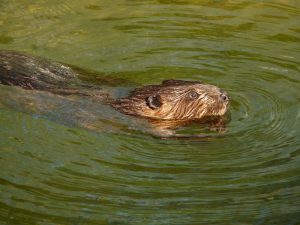Beaver Removal
281-667-0171
What is a beaver?
A beaver is North America’s largest rodent! That’s right, kids — a relative of the mouse, squirrel, and rat! Beavers are pretty big, weighing 40-60 pounds, and growing 3 to 4 feet from nose to tail.
They have short legs and necks and are built thick and stocky in the body. They have a thick double fur (called a pelt) and lots of body fat to keep them warm when swimming for hours. Beavers can easily dive and swim underwater for 10 minutes at a time.
Why are beavers called nature’s engineers?
Cities don’t look the the countryside, and that’s because of all the buildings in cities.Engineers are the people who plan how to put up a building or bridge or dam; they have to really know what they are doing so things don’t fall down!.Beavers are called nature’s engineers because they can really change the way an area looks,and, they are pretty good builders! You just learned how they build very cozy lodges, with an underwater door, mud plaster, a skylight for air and light, and a handy snack stash by the front door for those cold winter nights. That sounds good so far — that is, if you are the beaver. Beavers can also dredge (scrape out) underwater channels — grooves in the bottom of a lake that they follow from place to place, and they can build canals, passages of water to a favorite eating place or to another pond. It’s pretty exciting to see a beaver “construction project”, but, what if a beaver colony moves in to your backyard and starts building? Let’s see what would happen.
I don’t want engineers in MY backyard!
Because of all the changes they bring in the way the land looks, park managers have to decide what to do about them. Trapping (capturing beaver for their pelts) is not permitted in the national recreation area, and since
there are few animals here that hunt beaver for food, the number of beaver in the park keeps growing. Like you, they like it here! Also, since more and more houses are being built in the countryside near the park, there are less places to for beaver to live outside of the park. So, more and more beavers in smaller and fewer areas every year. What do you think a park manager should do when a beaver colony moves into an area and begins to flood a grassy meadow that is home to some endangered plants? (What’s endangered? See the Kids Home Page!) Should we let the beavers do what they do? Try to keep them from flooding the special places but leave them alone everywhere else, or just hope they will go away? (They won’t!). Source
The Houston Tx area is a great place for beavers. We have lots of waterways in our community, irrigation ditches, storm drains, canals, swamps, lakes, streams, reservoirs, bayous, creeks and ponds. These places are absolutely perfect for beavers. We have abundant trees to support their food requirements. They prefer soft trees but will use all trees for different reasons. Beavers are the original engineers for dam construction. They build beaver dam for multiple reasons. They use it to raise the water level because it is easier for beaver to float a tree limb than drag it. Another reason is it aids them in building the Beaver lodge. Beaver also stash their food right at the entrance to the beaver lodge. The lodge (home) is typically half in and half out of the water with a minimum of one entrance under the water. They spend the majority of their life either floating on top or under the surface. Also Beavers are nocturnal animals. The baby season for beavers are typically April, May, and June. Baby Beaver (kits) are capable of swimming at only 24 hrs after birth.

Beaver swimming in drainage canal
Beaver Control
If your nuisance beavers are chewing down your trees or damming up your creeks or canals. Call The Critter Team for a inspection to remove the beaver and dam

